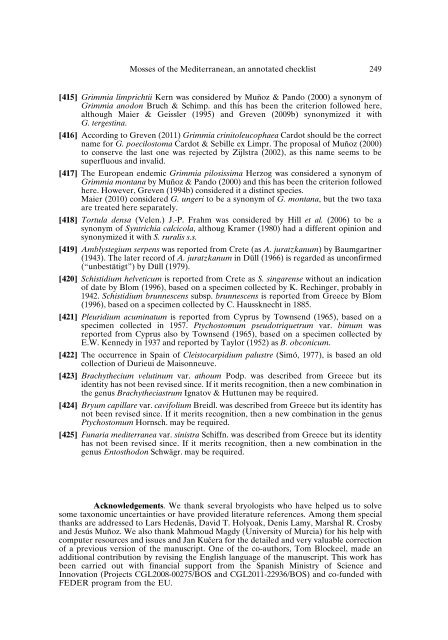Mosses of the Mediterranean, an annotated checklist - Optima-bot.org
Mosses of the Mediterranean, an annotated checklist - Optima-bot.org
Mosses of the Mediterranean, an annotated checklist - Optima-bot.org
You also want an ePaper? Increase the reach of your titles
YUMPU automatically turns print PDFs into web optimized ePapers that Google loves.
<strong>Mosses</strong> <strong>of</strong> <strong>the</strong> <strong>Mediterr<strong>an</strong>e<strong>an</strong></strong>, <strong>an</strong> <strong>an</strong>notated <strong>checklist</strong> 249[415] Grimmia limprichtii Kern was considered by Muñoz & P<strong>an</strong>do (2000) a synonym <strong>of</strong>Grimmia <strong>an</strong>odon Bruch & Schimp. <strong>an</strong>d this has been <strong>the</strong> criterion followed here,although Maier & Geissler (1995) <strong>an</strong>d Greven (2009b) synonymized it withG. tergestina.[416] According to Greven (2011) Grimmia crinitoleucophaea Cardot should be <strong>the</strong> correctname for G. poecilostoma Cardot & Sebille ex Limpr. The proposal <strong>of</strong> Muñoz (2000)to conserve <strong>the</strong> last one was rejected by Zijlstra (2002), as this name seems to besuperfluous <strong>an</strong>d invalid.[417] The Europe<strong>an</strong> endemic Grimmia pilosissima Herzog was considered a synonym <strong>of</strong>Grimmia mont<strong>an</strong>a by Muñoz & P<strong>an</strong>do (2000) <strong>an</strong>d this has been <strong>the</strong> criterion followedhere. However, Greven (1994b) considered it a distinct species.Maier (2010) considered G. ungeri to be a synonym <strong>of</strong> G. mont<strong>an</strong>a, but <strong>the</strong> two taxaare treated here separately.[418] Tortula densa (Velen.) J.-P. Frahm was considered by Hill et al. (2006) to be asynonym <strong>of</strong> Syntrichia calcicola, althoug Kramer (1980) had a different opinion <strong>an</strong>dsynonymized it with S. ruralis s.s.[419] Amblystegium serpens was reported from Crete (as A. juratzk<strong>an</strong>um) by Baumgartner(1943). The later record <strong>of</strong> A. juratzk<strong>an</strong>um in Düll (1966) is regarded as unconfirmed(“unbestätigt”) by Düll (1979).[420] Schistidium helveticum is reported from Crete as S. singarense without <strong>an</strong> indication<strong>of</strong> date by Blom (1996), based on a specimen collected by K. Rechinger, probably in1942. Schistidium brunnescens subsp. brunnescens is reported from Greece by Blom(1996), based on a specimen collected by C. Haussknecht in 1885.[421] Pleuridium acuminatum is reported from Cyprus by Townsend (1965), based on aspecimen collected in 1957. Ptychostomum pseudotriquetrum var. bimum wasreported from Cyprus also by Townsend (1965), based on a specimen collected byE.W. Kennedy in 1937 <strong>an</strong>d reported by Taylor (1952) as B. obconicum.[422] The occurrence in Spain <strong>of</strong> Cleistocarpidium palustre (Simó, 1977), is based <strong>an</strong> oldcollection <strong>of</strong> Durieui de Maisonneuve.[423] Brachy<strong>the</strong>cium velutinum var. athoum Podp. was described from Greece but itsidentity has not been revised since. If it merits recognition, <strong>the</strong>n a new combination in<strong>the</strong> genus Brachy<strong>the</strong>ciastrum Ignatov & Huttunen may be required.[424] Bryum capillare var. cavifolium Breidl. was described from Greece but its identity hasnot been revised since. If it merits recognition, <strong>the</strong>n a new combination in <strong>the</strong> genusPtychostomum Hornsch. may be required.[425] Funaria mediterr<strong>an</strong>ea var. sinistra Schiffn. was described from Greece but its identityhas not been revised since. If it merits recognition, <strong>the</strong>n a new combination in <strong>the</strong>genus Entosthodon Schwägr. may be required.Acknowledgements. We th<strong>an</strong>k several bryologists who have helped us to solvesome taxonomic uncertainties or have provided literature references. Among <strong>the</strong>m specialth<strong>an</strong>ks are addressed to Lars Hedenäs, David T. Holyoak, Denis Lamy, Marshal R. Crosby<strong>an</strong>d Jesús Muñoz. We also th<strong>an</strong>k Mahmoud Magdy (University <strong>of</strong> Murcia) for his help withcomputer resources <strong>an</strong>d issues <strong>an</strong>d J<strong>an</strong> Kuªera for <strong>the</strong> detailed <strong>an</strong>d very valuable correction<strong>of</strong> a previous version <strong>of</strong> <strong>the</strong> m<strong>an</strong>uscript. One <strong>of</strong> <strong>the</strong> co-authors, Tom Blockeel, made <strong>an</strong>additional contribution by revising <strong>the</strong> English l<strong>an</strong>guage <strong>of</strong> <strong>the</strong> m<strong>an</strong>uscript. This work hasbeen carried out with fin<strong>an</strong>cial support from <strong>the</strong> Sp<strong>an</strong>ish Ministry <strong>of</strong> Science <strong>an</strong>dInnovation (Projects CGL2008-00275/BOS <strong>an</strong>d CGL2011-22936/BOS) <strong>an</strong>d co-funded withFEDER program from <strong>the</strong> EU.






